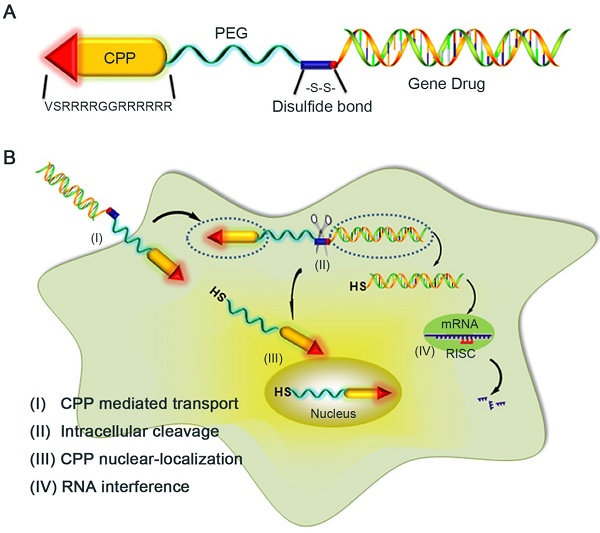当前位置:
X-MOL 学术
›
Theranostics
›
论文详情
Our official English website, www.x-mol.net, welcomes your feedback! (Note: you will need to create a separate account there.)
PSMA-Targeted Theranostic Nanocarrier for Prostate Cancer
Theranostics ( IF 12.4 ) Pub Date : 2017-06-24 , DOI: 10.7150/thno.18879 Orielyz Flores , Santimukul Santra , Charalambos Kaittanis , Rania Bassiouni , Amr S Khaled , Annette R. Khaled , Jan Grimm , J Manuel Perez
Theranostics ( IF 12.4 ) Pub Date : 2017-06-24 , DOI: 10.7150/thno.18879 Orielyz Flores , Santimukul Santra , Charalambos Kaittanis , Rania Bassiouni , Amr S Khaled , Annette R. Khaled , Jan Grimm , J Manuel Perez

|
Herein, we report the use of a theranostic nanocarrier (Folate-HBPE(CT20p)) to deliver a therapeutic peptide to prostate cancer tumors that express PSMA (folate hydrolase 1). The therapeutic peptide (CT20p) targets and inhibits the chaperonin-containing TCP-1 (CCT) protein-folding complex, is selectively cytotoxic to cancer cells, and is non-toxic to normal tissue. With the delivery of CT20p to prostate cancer cells via PSMA, a dual level of cancer specificity is achieved: (1) selective targeting to PSMA-expressing prostate tumors, and (2) specific cytotoxicity to cancer cells with minimal toxicity to normal cells. The PSMA-targeting theranostic nanocarrier can image PSMA-expressing cells and tumors when a near infrared dye is used as cargo. Meanwhile, it can be used to treat PSMA-expressing tumors when a therapeutic, such as the CT20p peptide, is encapsulated within the nanocarrier. Even when these PSMA-targeting nanocarriers are taken up by macrophages, minimal cell death is observed in these cells, in contrast with doxorubicin-based therapeutics that result in significant macrophage death. Incubation of PSMA-expressing prostate cancer cells with the Folate-HBPE(CT20p) nanocarriers induces considerable changes in cell morphology, reduction in the levels of integrin β1, and lower cell adhesion, eventually resulting in cell death. These results are relevant as integrin β1 plays a key role in prostate cancer invasion and metastatic potential. In addition, the use of the developed PSMA-targeting nanocarrier facilitates the selective in vivo delivery of CT20p to PSMA-positive tumor, inducing significant reduction in tumor size.
中文翻译:

针对前列腺癌的PSMA靶向治疗性纳米载体
在本文中,我们报道了使用治疗性纳米载体(Folate-HBPE(CT20p))将治疗性肽递送至表达PSMA的前列腺癌肿瘤(叶酸水解酶1)。治疗性肽(CT20p)靶向并抑制含伴侣蛋白的TCP-1(CCT)蛋白折叠复合物,对癌细胞具有选择性细胞毒性,对正常组织无毒性。通过经由PSMA将CT20p递送至前列腺癌细胞,可以达到双重的癌症特异性:(1)选择性靶向表达PSMA的前列腺肿瘤,以及(2)对癌细胞的特异性细胞毒性,而对正常细胞的毒性最小。当将近红外染料用作货物时,靶向PSMA的治疗性纳米载体可以使表达PSMA的细胞和肿瘤成像。同时,它可以用于治疗表达PSMA的肿瘤,例如CT20p肽,被包封在纳米载体内。即使这些靶向PSMA的纳米载体被巨噬细胞吸收,与导致大量巨噬细胞死亡的基于阿霉素的疗法相比,在这些细胞中也观察到了最小的细胞死亡。用叶酸-HBPE(CT20p)纳米载体孵育表达PSMA的前列腺癌细胞会引起细胞形态的显着变化,整合素β1的水平降低以及细胞黏附力降低,最终导致细胞死亡。这些结果是有意义的,因为整联蛋白β1在前列腺癌的侵袭和转移潜能中起着关键作用。此外,开发的靶向PSMA的纳米载体的使用有助于选择性 与基于阿霉素的疗法相反,后者会导致巨噬细胞大量死亡。用叶酸-HBPE(CT20p)纳米载体孵育表达PSMA的前列腺癌细胞会引起细胞形态的显着变化,整合素β1的水平降低以及细胞黏附力降低,最终导致细胞死亡。这些结果是有意义的,因为整联蛋白β1在前列腺癌的侵袭和转移潜能中起着关键作用。此外,开发的靶向PSMA的纳米载体的使用有助于选择性 与基于阿霉素的疗法相反,后者会导致巨噬细胞大量死亡。用叶酸-HBPE(CT20p)纳米载体孵育表达PSMA的前列腺癌细胞会引起细胞形态的显着变化,整合素β1的水平降低以及细胞黏附力降低,最终导致细胞死亡。这些结果是有意义的,因为整联蛋白β1在前列腺癌的侵袭和转移潜能中起着关键作用。此外,开发的靶向PSMA的纳米载体的使用有助于选择性 最终导致细胞死亡。这些结果是有意义的,因为整联蛋白β1在前列腺癌的侵袭和转移潜能中起着关键作用。此外,开发的靶向PSMA的纳米载体的使用有助于选择性 最终导致细胞死亡。这些结果是有意义的,因为整联蛋白β1在前列腺癌的侵袭和转移潜能中起着关键作用。此外,开发的靶向PSMA的纳米载体的使用有助于选择性将CT20p体内递送至PSMA阳性肿瘤,导致肿瘤大小显着减少。
更新日期:2017-09-04
中文翻译:

针对前列腺癌的PSMA靶向治疗性纳米载体
在本文中,我们报道了使用治疗性纳米载体(Folate-HBPE(CT20p))将治疗性肽递送至表达PSMA的前列腺癌肿瘤(叶酸水解酶1)。治疗性肽(CT20p)靶向并抑制含伴侣蛋白的TCP-1(CCT)蛋白折叠复合物,对癌细胞具有选择性细胞毒性,对正常组织无毒性。通过经由PSMA将CT20p递送至前列腺癌细胞,可以达到双重的癌症特异性:(1)选择性靶向表达PSMA的前列腺肿瘤,以及(2)对癌细胞的特异性细胞毒性,而对正常细胞的毒性最小。当将近红外染料用作货物时,靶向PSMA的治疗性纳米载体可以使表达PSMA的细胞和肿瘤成像。同时,它可以用于治疗表达PSMA的肿瘤,例如CT20p肽,被包封在纳米载体内。即使这些靶向PSMA的纳米载体被巨噬细胞吸收,与导致大量巨噬细胞死亡的基于阿霉素的疗法相比,在这些细胞中也观察到了最小的细胞死亡。用叶酸-HBPE(CT20p)纳米载体孵育表达PSMA的前列腺癌细胞会引起细胞形态的显着变化,整合素β1的水平降低以及细胞黏附力降低,最终导致细胞死亡。这些结果是有意义的,因为整联蛋白β1在前列腺癌的侵袭和转移潜能中起着关键作用。此外,开发的靶向PSMA的纳米载体的使用有助于选择性 与基于阿霉素的疗法相反,后者会导致巨噬细胞大量死亡。用叶酸-HBPE(CT20p)纳米载体孵育表达PSMA的前列腺癌细胞会引起细胞形态的显着变化,整合素β1的水平降低以及细胞黏附力降低,最终导致细胞死亡。这些结果是有意义的,因为整联蛋白β1在前列腺癌的侵袭和转移潜能中起着关键作用。此外,开发的靶向PSMA的纳米载体的使用有助于选择性 与基于阿霉素的疗法相反,后者会导致巨噬细胞大量死亡。用叶酸-HBPE(CT20p)纳米载体孵育表达PSMA的前列腺癌细胞会引起细胞形态的显着变化,整合素β1的水平降低以及细胞黏附力降低,最终导致细胞死亡。这些结果是有意义的,因为整联蛋白β1在前列腺癌的侵袭和转移潜能中起着关键作用。此外,开发的靶向PSMA的纳米载体的使用有助于选择性 最终导致细胞死亡。这些结果是有意义的,因为整联蛋白β1在前列腺癌的侵袭和转移潜能中起着关键作用。此外,开发的靶向PSMA的纳米载体的使用有助于选择性 最终导致细胞死亡。这些结果是有意义的,因为整联蛋白β1在前列腺癌的侵袭和转移潜能中起着关键作用。此外,开发的靶向PSMA的纳米载体的使用有助于选择性将CT20p体内递送至PSMA阳性肿瘤,导致肿瘤大小显着减少。


























 京公网安备 11010802027423号
京公网安备 11010802027423号